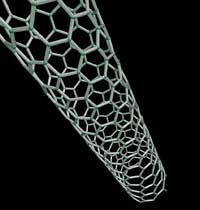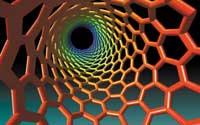Cleaning nanotubes, cheap nanotubes
2001/03/12 Roa Zubia, Guillermo - Elhuyar Zientzia
In the field of new materials, numerous applications have been assigned to the fulerenes exposed years ago. In addition, these applications are increasingly detailed. Two factors contribute to this new path. On the one hand, scientists' own ingenuity is of great originality, since the new uses that these molecules can have in unforeseen fields are constantly being invented. On the other hand, cheaper methods of synthesis of fulerenes and nanotubes are being developed.
Fulerenes are ball-shaped molecules formed by carbon. When the same material is cylindrical, nanotubes are created. Other materials can be used for the manufacture of nanotubes. All these molecules have the ability to make cage and, therefore, the applications that have been invented depend on what they can catch inside.
On the website of the journal Nature this week has been released the application that can be of great interest to the industrial world. Richard Long and Ralph Yang, scientists at the University of Michigan, have stated that nanotubes can clean dioxins. Dioxins are dangerous contaminants. Some are carcinogenic and others have important effects on hormone and immune systems. In most countries, dioxin production has been subjected to strict restrictions, but it is not enough to preserve the environment.
The nanotubes have holes of sufficient size to allow the passage of gases. It can behave like a porous graphite. If the gas passes through the confusions, the dioxin molecules would be blocked and the emitted gases would be clean. However, for industrial use it will be necessary to find a way to make nanotubes cheap.
Nanoscopic conductors
Nanotubes are electrical conductors that form a very resistant material. Therefore, the scientists, considering their size, considered that it was an ideal material for chip wiring.
The usual method of manufacturing nanotubes is the generation of electrical current between two carbon electrodes. It is a very effective method, but it usually presents great difficulties to bring the molecules generated to suitable places. The solution would be to directly create the nanotube inside the chip.
It is known that if a flat layer of semiconductor is released from the bottom bracket, it will be rounded by itself. Oliver Schmidt and Karl Eberl, physicists at the Max Planck Institute in Stuttgart, discovered that this effect can be used to manufacture nanotubes. Some chemical compounds can release the bottom layer of a semiconductor and the top layer form a nanotube. In addition, changing the components of the layer, you can control the diameter of the tube. The scientists were surprised because it was such a simple idea that no other person had ever occurred before.

Gai honi buruzko eduki gehiago
Elhuyarrek garatutako teknologia






